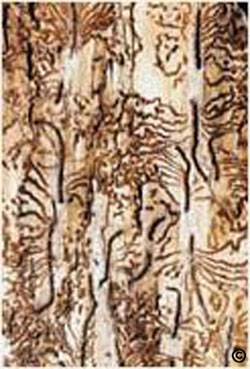Among evergreen forest insects, bark beetles are a very prominent problem. The most notorious of the bark beetles is the mountain pine beetle. Various forested areas throughout Colorado have sustained extensive damage from mountain pine beetle attacks.
In urban areas, however, the primary culprits are typically one of the various Ips species. Ips beetles can frequently be found in ponderosa, lodgepole, piñon, limber, Austrian and bristlecone pines as well as spruce.
When Ips beetle infested trees are cut down, the resulting piles of slash can still harbor the insect. It takes about six weeks for Ips beetles to complete their life cycle in the piles. Ips will attack freshly cut bark that is intact and fairly moist. After they have emerged from the cut logs or the bark pulls off easily, it is no longer inhabitable for Ips.
There are several species of what are known as “secondary” bark beetles found in evergreens as well. A “secondary” insect is one that infests plants already weakened by something else such as another pest, mechanical damage or poor care.
An example is the red turpentine beetle, which infests the lower few feet of damaged or stressed pine tree trunks. Different species of twig beetles attack branches, tops and small branches of stressed or recently transplanted trees.
If a recently transplanted tree is being threatened, bark beetle sprays such as Sevin or permethrin should be applied the day of transplanting. Otherwise preventive treatments for these pests are not usually needed on a routine basis.
There are no insecticides that will kill beetles once they have successfully infested a tree. Permethrin and carbaryl are effective preventives against both mountain pine beetle and Ips beetle.
For more information, see the following Colorado State University Extension fact sheet(s).



